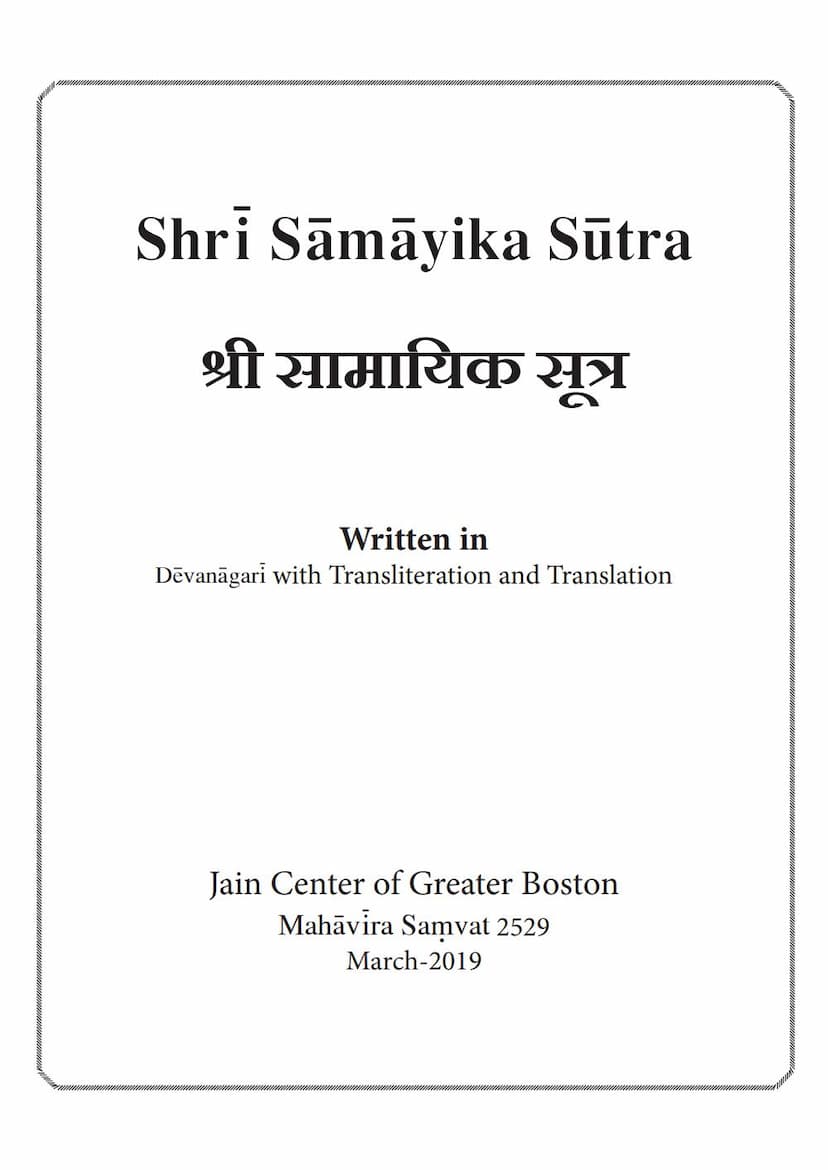Samayik Sutra
Added to library: September 2, 2025

Summary
This document is a booklet titled "Shri Sāmāyika Sūtra," published by the Jain Center of Greater Boston in March 2019. It aims to guide individuals, particularly youth, in performing the Jain practice of Sāmāyika, which means equanimity.
Here's a comprehensive summary of its content:
Purpose and Target Audience: The booklet is designed as a simple, step-by-step guide for anyone who doesn't know the necessary sutras and ritual procedures for Sāmāyika. It specifically caters to English-speaking youth and adults who may not be fluent in Hindi or Gujarati, making the practice accessible.
Key Components:
- Transliteration and Translation: The booklet provides the original Prakrit sutras in Devanagari script, followed by their English transliterations and translations. This is crucial for understanding and correct pronunciation.
- Structure: The booklet is organized into several sections:
- Section 1: How to Use This Booklet: Explains the purpose and how to best utilize the booklet, emphasizing the importance of the transliteration guide and parental/teacher guidance.
- Section 2: What is Sāmāyika: Defines Sāmāyika as "Equanimity," describing it as a state of calm, undisturbedness, and freedom from passions. It highlights Sāmāyika as the essence of Tirthankara teachings, the first of the six Avasyakas (essentials), and crucial for spiritual progress and attaining Moksha.
- Section 3: Preparation for Sāmāyika: Lists necessary accessories (Charavalo, Kaṭāsanu, muhpatti, etc.) and outlines preparatory steps like wearing clean clothes, maintaining silence, and avoiding distractions.
- Section 4: Step-by-Step Initiation of Sāmāyika: Details the commencement of Sāmāyika, including:
- Consecration of Sthāpanāji (establishing a symbolic presence of a guru).
- Recitation of specific sutras like Khamāsamaņa, Navakāra, and Pañchindiya.
- Performing Iriyāvahiyam Pratikramaņa (a ritual of atonement for unintentional harm to living beings).
- Muhapatti Padilehan Procedure (a ritual involving cleaning the cloth used to cover the mouth).
- Taking the vow of Sāmāyika.
- Preparation for the 48 minutes of equanimity, including seeking permission to sit and engage in religious study or meditation.
- Section 5: A Step-by-Step Procedure for Ending of Sāmāyika: Outlines the process of concluding Sāmāyika, which mirrors the initiation process in reverse, including Iriyāvahiyam Pratikramaņa, Muhapatti Padilehan, and seeking permission to end the vow.
- Section 6: Sūtras: This is the core of the booklet, presenting essential sutras with their Devanagari script, transliteration, and meaning. These include:
- Navakāra Mahāmantra: The fundamental Jain mantra.
- Pañchindiya Sūtra: Describing the virtues of a preceptor.
- Khamāsamaņa Sūtra: A ritual of apology and bowing.
- Ichchhakāra Sūtra: Seeking permission and well-being.
- Iriyāvahiyā Sūtra: Attonement for harm to living beings during movement.
- Tassauttari Sūtra: Preparing for spiritual meditation (Kāyotsarga).
- Annatha Sūtra: Acknowledging potential minor interruptions during meditation.
- Logassa Sūtra: A prayer to the 24 Tirthankaras.
- Karēmi Bhantē Sūtra: The vow of Sāmāyika.
- Sāta Lakha Sūtra: A comprehensive prayer for forgiveness for harming the various forms of life.
- Uvasaggaharam Sūtra: A hymn to Lord Parshvanatha.
- Guru Vandana Sūtra: Showing respect to the Guru.
- Section 7: Pratyākhyānas: Explains the concept of taking vows (Pratyākhyānas or Pachchakkhāņa) for sense control and spiritual pursuit, providing examples of simple vows like abstaining from food and drink at specific times.
- Section 8: References and Acknowledgement: Credits the sources used, including other Jain texts and individuals who assisted in the publication, and emphasizes that no originality is claimed.
Key Jain Principles Emphasized:
- Ahimsa (Non-violence): This is presented as the supreme principle, evident in the Iriyāvahiyā Sūtra and the Sāta Lakha Sūtra, which focus on acknowledging and seeking forgiveness for harming living beings.
- Equanimity (Sāmāyika): The central theme, essential for spiritual progress and liberation.
- Respect for Gurus: The use of "Ichchhākārēņa Sandisaha Bhagavan" (Oh, forgiving Gurudev) throughout the initiation and ending procedures highlights the importance of guru-disciple relationship.
- Austerity and Self-Control: Implied in the preparation and the nature of Sāmāyika itself, as well as in the Pratyākhyānas.
- Importance of Original Texts: The preface stresses the significance of preserving original Sanskrit and Prakrit texts, as translations can lose the deep spiritual nuances.
- Devotion and Faith: The various sutras, especially those honoring Tirthankaras and gurus, reflect deep devotion.
Overall Significance: The "Shri Sāmāyika Sūtra" booklet by the Jain Center of Greater Boston serves as a valuable resource for the Jain community, particularly for those seeking to learn and practice Sāmāyika in a structured and accessible manner. It bridges the gap between traditional Jain practices and the needs of a modern, English-speaking audience, promoting the core tenets of Jainism through a practical guide.